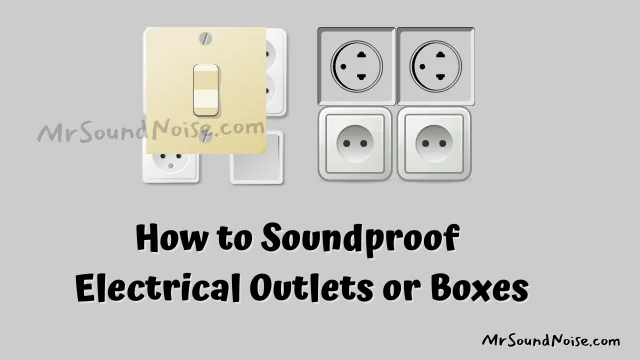
You have faced problems with soundproofing electrical boxes and outlets and receptacles, during the application of acoustic material.
You have the idea for the application of acoustic elements in the flat surface of your room. But at this moment, you don’t understand how to block the gaps around the electric box.
Because this section is a sensitive issue and all time the electricity is available in the electrical outlets.
Now, you also have confusion about which material you should apply to soundproof these electrical outlets, wiring devices, and screwless wall plates.
There are some holes, gaps, or air leakages on the side of this box. You need to instantly block those small ways so that any sound wave can’t pass through these ways.
If you want to soundproof the electrical board (outlets and junction boxes), I think you have come to the right place for knowing some reliable ideas to solve this issue.
So continue reading…
Some people also don’t know the difference between electric outlets and boxes. First, you should be clear about this topic.
What are Electrical Outlets and Boxes
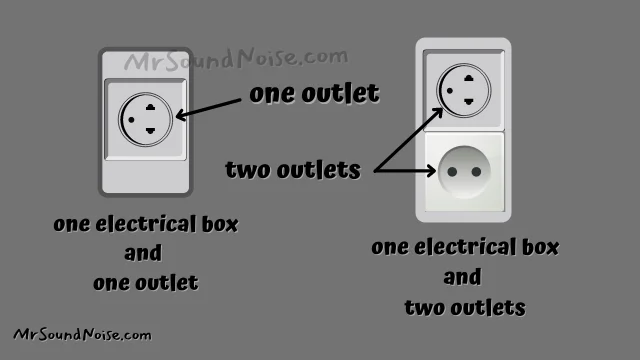
An electrical outlet is the source of electric power. There are also other names of this outlet. Yes, electrical sockets or electrical plugs are also the other names of this outlet.
On the other hand, an air seal electrical box may contain one outlet or multiple outlets. See the image, you can understand the difference between outlet and electric box.
Is it Possible to Soundproof Electrical Outlets/Boxes?
Do some people also have a confusion that is it possible to soundproof the electrical box? Yes, it is possible to block all the gaps of that box, if you can follow the proper guideline and apply exact acoustic material to that box.
Don’t worry, the process of soundproofing this box is not tough to work. You can do it easily if you have experience with electrical work.
If you don’t know any electricity-related work, you can get help from an electrician for applying the soundproofing methods.
Before starting to apply any acoustic material to the electric area, you should turn off the connection of the power supply (ensure the protection of electric shock). If you don’t disconnect electricity, you may get shocked anytime. Before starting any acoustic element to the electricity side, of course, be sure it is fire resistant.
How to Soundproof the Electrical Box or Outlets
There are some ways around the electric box and outlets where sound can pass. You have installed acoustic material except for electric areas.
So now you need to block the gaps and holes of this area urgently. This is the reason why I am sharing some basic ways that you should know for applying soundproof material to this type of electrical area.
1. Using Acoustic Putty
Most people know this kind of putty. If you are a new person, then you may have a question that…
What are the acoustic putty pads?
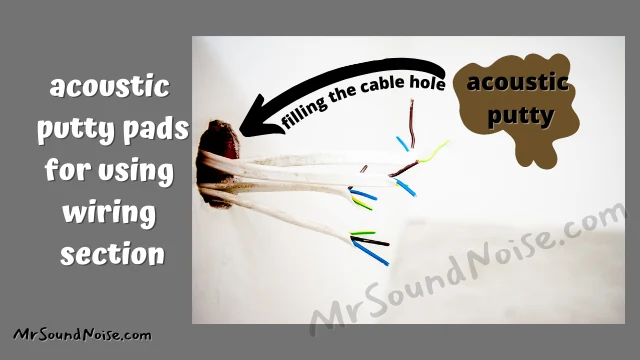
I will now tell you about it with a short description. It is one kind of sound damping material that reduces airborne noise. It is super malleable and you can convert it to any shape.
This is why you can apply these putty pads for soundproofing to any kind of gap or holes in electrical boxes or outlets.
The weak points of the electrical boxes and outlets should be wrapped by putty. (source)
What is an intumescent putty?
This is also malleable type material that is also used for using inside, outside, and around the electrical box, sockets or outlets. It is also one kind of firestop and soundproof putty pad.
It’s not like other putty and you should use these specific soundproof or acoustical putty pads to all sides of the outlets’ area.
N.B: You have already used acoustic sealant for filling the gaps (wall cavities) of concrete walls, board walls, or the layers of drywall, door, and windows areas. If you have a question: Does a concrete wall absorb sound? you should know this topic. Now you should use this type of acoustic putty in the electrical areas.
The main task of this putty is to increase fire resistance and it is also soundproof.
How to use this putty:
At first, you should find out the gaps and wiring holes around the outlets. Then apply the putty to that place and ensure that there is no gap.
You should unscrew the electrical box if needed. This is how you can use quiet putty pads.
2. Filling the Cavity or Gap Around the Outlet
a. Use Mineral Wool for Insulation
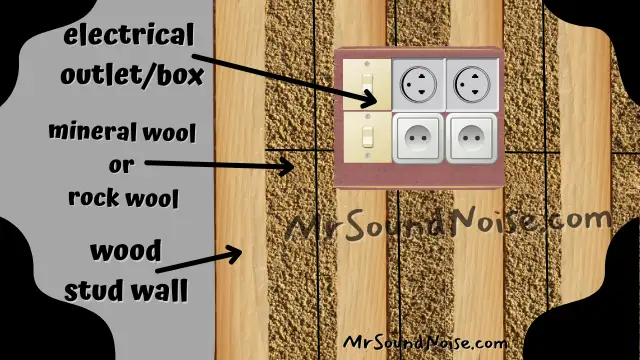
If you have stud (wood or other materials) walls, they need to block the gap with mineral wool or other fabric.
Rockwool material is one kind of mineral wool that you can use to the stud wall where you have already installed an electrical box.
If you can’t understand the setting of this type of wool, you can see this image for clearing your confusion.
If you have a wood wall and have a question: does wood absorb sound? you may know it for knowing more.
b. With Acoustic Sealant or Expanding Foam
If you have gaps around the wall side, you can use an acoustic type of foam panels and sealant (acoustical caulk seal) which is very useful for soundproofing wall gaps and door gaps. You can get the caulk tubes from any marketplace.
3. Using the Seal of the Electrical (Outlet) Box
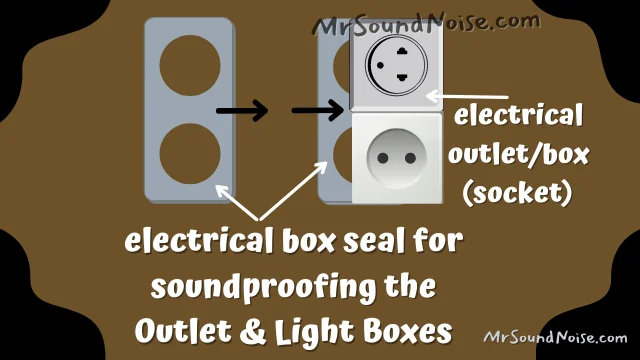
Normal electrical outlet boxes are not properly soundproof. This is why you need to use the electrical box seal which can block the sound transfer instantly.
Remember: The collected box should be waterproof and fire-resistant too.
You can use the seal pad (see the image) in the electrical box. Using this type of pad helps to reduce sound transfer.
It is a gasket type of seal pad that covers the gap of all the outlet box areas. A variety of colors of this seal is available in the market.
N.B: It is also needed to soundproof the ceiling section if you want to stop the sound transfer through the ceiling part. Soundproofing a specific wall is also important when you set up an outlet box.
If you think that you can reduce total noise from home by setting soundproof material in the outlet box, then I want to tell you that you are wrong.
You should focus on soundproofing a window and door by using reliable weatherstripping and other acoustic materials.
My Overview
In summary, I will tell you that you should be careful before applying any soundproofing material to the outlet box. Because this area is dangerous for working people.
If you used to work in the electric area, then you can start noise-reducing activities in that area. If you don’t have any experience, you should help the other person who has no problem working in this area.
Of course, you should take help from an electrician before doing any implementation of the electrical panels or outlets.
You can give the soundproofing idea to that person so that he can easily apply a soundproofing element to the electric area like outlet box, sockets, etc.
You may try a flex duct seal for covering electrical wires too. So I have shared some points for those who don’t have any idea about reducing noise from the outlet box.
If you read these points, you can also get reliable information for implementing acoustic materials in the electric section.
N.B: You should know building codes and local electrical codes before soundproofing the electric outlets.
You can read some more questions that are given in the FAQ section. After reading these questions with answers, I think you can also get some important data.
If you want to know the details, you can read the total post from here.
FAQ: Soundproof Electrical Outlets
Can You Use Putty to Remove Flanking Noise?
Some noise comes to the room through indirect paths like ceiling structure, basement section, wiring outlets (except the wall section) and it is called flanking noise.
It is indirect noise that comes to your room through these paths. Transferring the noise through a direct wall is not considered flanking noise.
By using acoustic putty you can reduce this type of external or internal noise because it is designed for this purpose.
So for reducing this type of noise you should apply acoustic elements to the floor section and ceiling area too.
If you want to know the details, you can read the post where I have shared a clear overview of floor insulation and ceiling surface. At the same time, you should also focus on blocking the gaps in electric boxes and outlets.
How Can the Sound Transfer Through Electrical Boxes be Decreased?
By using acoustic putty, you can reduce maximum sound from transferring any electric box or outlet. Besides, you can use a sealed electrical box to replace the normal box.
You can also use the seal pad (soundproof gasket or foam gasket) to the outlet box for blocking the required gaps.
What do Putty Pads Do?
The main function of a putty pad is to add fire resistance. You may also be curious if acoustic putty pads work for noise reduction in the outlet area?
To answer this question, I want to say that it works and most people are using this malleable material in the outlet box for decreasing noise.
Where do You Normally Put Putty Pads?
Normally putty pads are used in the electrical area for decreasing noise transmission. Besides, you can also use it on the other side of your room.
Do You Use Acoustical Sealant in Replacing Putty?
It will be better if you should only use acoustic putty in the electric or heat area. Because this type of material is specially made for use in this section.
You can get both the facility like soundproofing and heat resistance by using this material. Besides, you can also use it in other places, if the acoustic sealant is not available.
On the other hand, you should not use acoustic sealant to the electric area like wire (cable) soundproofing, outlet box, etc.
But this type of material is specially used in the gap or hole of the door and window side. It is used in the ceiling section too.
For blocking small types of gaps with soundproofing sealant is popular too. Now, I think, you have cleared the difference between using the area of the acoustic sealant and putty.
